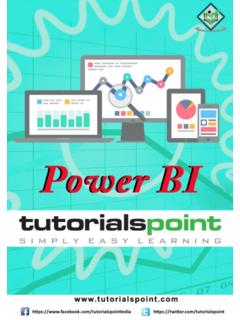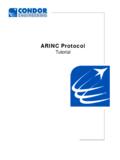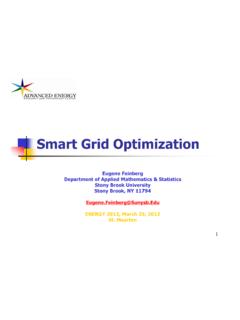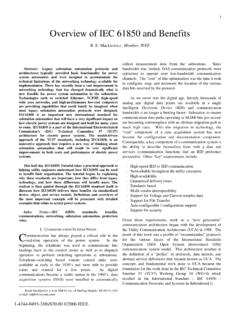Transcription of About the Tutorial - Current Affairs 2018, Apache Commons ...
1 Cognos i About the Tutorial IBM Cognos business intelligence is a web based reporting and analytic tool. It is used to perform data aggregation and create user friendly detailed reports. IBM Cognos provides a wide range of features and can be considered as an enterprise software to provide flexible reporting environment and can be used for large and medium enterprise. Cognos also provides you an option to export the report in XML or PDF format or you can view the reports in XML format. Audience IBM Cognos provides a wide range of features and can be considered as an enterprise software to provide flexible reporting environment and can be used for large and medium enterprises. It meets the needs of Power Users, Analysts, business Managers and Company Executives. Power users and analysts want to create ad-hoc reports and can create multiple views of the same data. business Executives want to see summarize data in dashboard styles, cross tabs and visualizations.
2 Cognos allows both the options for all set of users. Prerequisites IBM Cognos business intelligence is an advanced topic. Even though the content has been prepared keeping in mind the requirements of a beginner, the reader should be familiar with the fundamentals of running and viewing reports or manage schedules, portal layouts, and other users' permissions before starting with this Tutorial . Disclaimer & Copyright Copyright 2016 by tutorials Point (I) Pvt. Ltd. All the content and graphics published in this e-book are the property of tutorials Point (I) Pvt. Ltd. The user of this e-book is prohibited to reuse, retain, copy, distribute or republish any contents or a part of contents of this e-book in any manner without written consent of the publisher. We strive to update the contents of our website and tutorials as timely and as precisely as possible, however, the contents may contain inaccuracies or errors.
3 tutorials Point (I) Pvt. Ltd. provides no guarantee regarding the accuracy, timeliness or completeness of our website or its contents including this Tutorial . If you discover any errors on our website or in this Tutorial , please notify us at Cognos ii Table of Contents About the Tutorial .. i i Prerequisites .. i Disclaimer & Copyright .. i Table of Contents .. ii DATA WAREHOUSING .. 1 1. Data Warehouse Overview .. 2 Features of a Data Warehouse .. 3 Architecture of Data Warehouse .. 4 Characteristics of a Data Warehouse .. 5 OLTP vs OLAP .. 5 Data Mart Vs Data 7 Fact vs Dimension Table .. 8 2. Data Warehouse 9 Star Schema .. 9 Snowflakes Schema .. 10 Fact Constellation Schema (Galaxy Schema) .. 11 3. Data Warehouse ETL & Reporting Tools .. 12 Extraction .. 12 Transform .. 13 Load .. 13 BI Reporting Tool .. 13 COGNOS BASICS .. 14 4. Cognos Introduction .. 15 Key Features of IBM 15 Cognos Versions.
4 17 Cognos vs Other BI Reporting Tools .. 18 IBM Cognos vs SAP business Objects .. 19 5. Cognos Components and Services .. 20 Gateways .. 20 Application Tier Components .. 21 Content Manager .. 21 6. Cognos Connections .. 22 Connecting Different Data Sources .. 22 Creating a Data Source Connection in IBM Cognos .. 23 Data Source Security Setup .. 27 Cognos iii 7. Cognos Packages .. 28 How to Create a Package? .. 28 Scheduling Reports in IBM Cognos .. 29 8. Cognos Framework Manager .. 32 What is a Framework Manager? .. 32 Metadata Modeling .. 32 IBM Cognos Framework Manager User Interface .. 33 Importing Metadata from a Relational Database .. 34 9. Cognos Relationships in Metadata Model .. 37 Cardinality Concept .. 37 Relationship Notation in Metadata Model .. 38 Creating or Modifying the Relationships .. 38 Creating a Relationship Shortcut .. 40 Create a Query 40 Edit SQL .. 43 QUERY STUDIO.
5 45 10. Cognos Query Studio .. 46 11. Cognos Ad-hoc Reports .. 47 12. Cognos Report 50 13. Cognos Creating a Report .. 51 14. Cognos Open an Existing Report .. 53 15. Cognos Add Data to a Report .. 54 16. Cognos Saving a Report .. 55 17. Cognos Run a Report .. 57 Run a Report in PDF, XML, and CSV format .. 58 18. Cognos Printing a 59 REPORT STUDIO .. 60 19. Cognos Report 61 How to Create a Report in Report Studio? .. 61 How to Open Report Studio? .. 62 Cognos iv 20. Cognos Report Templates .. 63 List Report .. 63 Crosstab .. 63 Chart .. 64 Map .. 65 Repeater .. 65 21. Cognos List Report .. 66 22. Cognos Crosstab Report .. 69 Formatting a Crosstab .. 71 23. Cognos Creating a Chart .. 73 24. Cognos Report Functions .. 76 25. Cognos Report Validation .. 78 26. Cognos Report Run with Options .. 80 27. Cognos Report Administration .. 82 28. Cognos Filters.
6 84 Deleting a Filter .. 86 29. Cognos Custom Calculations .. 87 ANALYSIS STUDIO .. 89 30. Cognos Analysis Studio .. 90 Interface .. 90 31. Cognos Create an Analysis .. 92 32. Cognos Save an Analysis .. 94 33. Cognos Open Existing Analysis .. 95 EVENT STUDIO .. 96 34. Cognos Event Studio .. 97 35. Cognos Notification Methods .. 99 Cognos v Data Warehousing Cognos vi A Data Warehouse consists of data from multiple heterogeneous data sources and is used for analytical reporting and decision making. Data Warehouse is a central place where data is stored from different data sources and applications. The term Data Warehouse was first invented by Bill Inmom in 1990. A Data Warehouse is always kept separate from an Operational Database. The data in a DW system is loaded from operational transaction systems like Sales Marketing HR SCM, etc. It may pass through operational data store or other transformations before it is loaded to the DW system for information processing.
7 A Data Warehouse is used for reporting and analyzing of information and stores both historical and Current data. The data in DW system is used for Analytical reporting, which is later used by business Analysts, Sales Managers or Knowledge workers for decision-making. 1. Data Warehouse Overview Cognos vii In the above image, you can see that the data is coming from multiple heterogeneous data sources to a Data Warehouse. Common data sources for a data warehouse includes: Operational databases SAP and non-SAP Applications Flat Files (xls, csv, txt files) Data in data warehouse is accessed by BI ( business intelligence ) users for Analytical Reporting, Data Mining and Analysis. This is used for decision making by business Users, Sales Manager, Analysts to define future strategy. Features of a Data Warehouse It is a central data repository where data is stored from one or more heterogeneous data sources.
8 A DW system stores both Current and historical data. Normally a DW system stores 5-10 years of historical data. A DW system is always kept separate from an operational transaction system. The data in a DW system is used for different types of analytical reporting range from Quarterly to Annual comparison. Cognos viii Data Warehouse Vs Operational Database The differences between a Data Warehouse and Operational Database are as follows An Operational System is designed for known workloads and transactions like updating a user record, searching a record, etc. However, Data Warehouse transactions are more complex and present a general form of data. An Operational System contains the Current data of an organization and Data warehouse normally contains the historical data. An Operational Database supports parallel processing of multiple transactions. Concurrency control and recovery mechanisms are required to maintain consistency of the database.
9 An Operational Database query allows to read and modify operations (insert, delete and Update) while an OLAP query needs only read-only access of stored data (Select statement). Architecture of Data Warehouse Data Warehousing involves data cleaning, data integration, and data consolidations. A Data Warehouse has a 3-layer architecture Data Source Layer It defines how the data comes to a Data Warehouse. It involves various data sources and operational transaction systems, flat files, applications, etc. Integration Layer It consists of Operational Data Store and Staging area. Staging area is used to perform data cleansing, data transformation and loading data from different sources to a data warehouse. As multiple data sources are available for extraction at different time zones, staging area is used to store the data and later to apply transformations on data. Presentation Layer This is used to perform BI reporting by end users.
10 The data in a DW system is accessed by BI users and used for reporting and analysis. Cognos ix The following illustration shows the common architecture of a Data Warehouse System. Characteristics of a Data Warehouse The following are the key characteristics of a Data Warehouse: Subject Oriented: In a DW system, the data is categorized and stored by a business subject rather than by application like equity plans, shares, loans, etc. Integrated: Data from multiple data sources are integrated in a Data Warehouse. Non Volatile: Data in data warehouse is non-volatile. It means when data is loaded in DW system, it is not altered. Time Variant: A DW system contains historical data as compared to Transactional system which contains only Current data. In a Data warehouse you can see data for 3 months, 6 months, 1 year, 5 years, etc. OLTP vs OLAP Firstly, OLTP stands for Online Transaction Processing, while OLAP stands for Online Analytical Processing In an OLTP system, there are a large number of short online transactions such as INSERT, UPDATE, and DELETE.


















